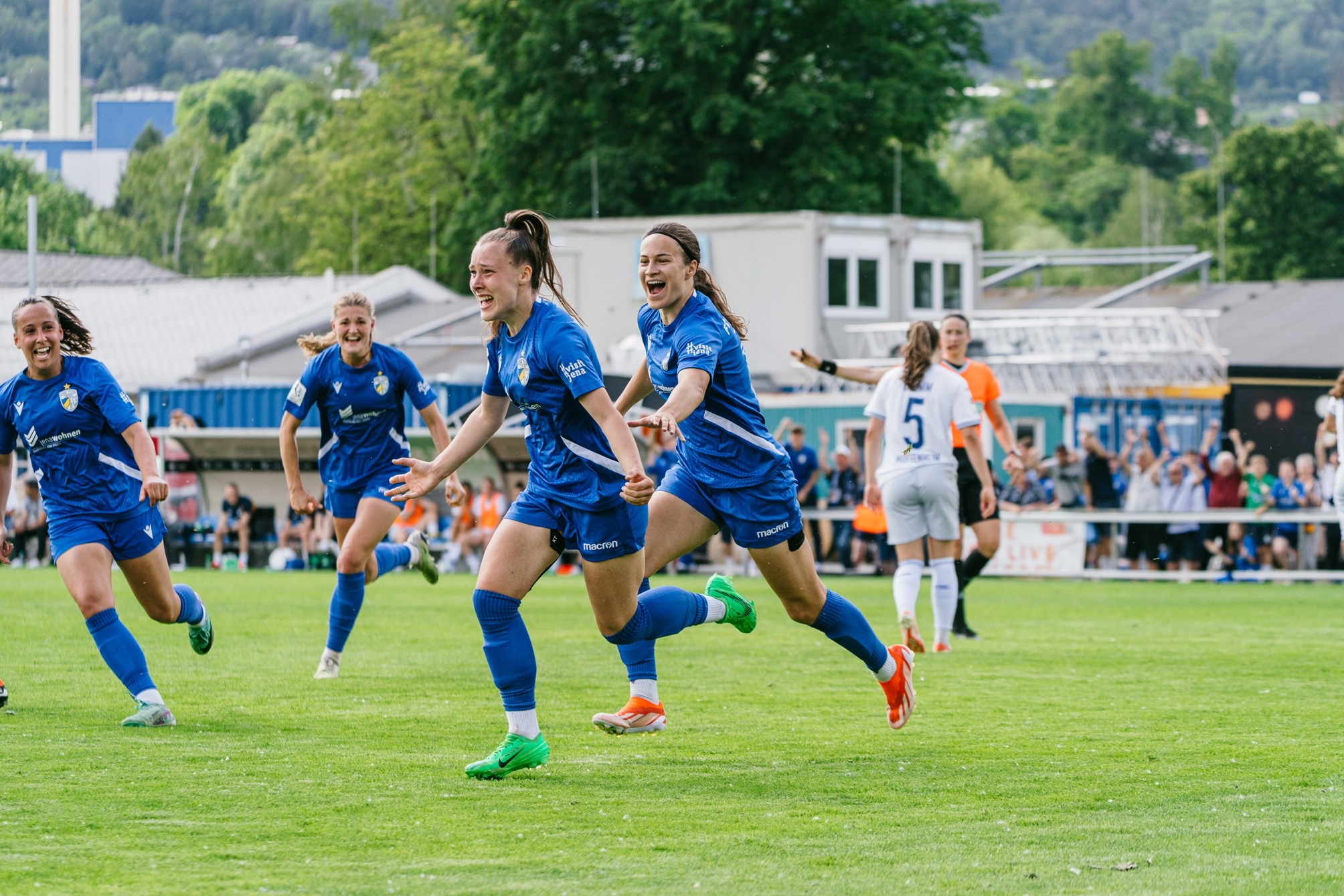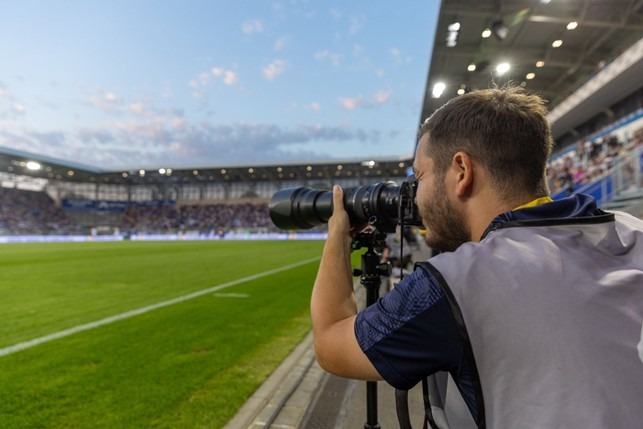In November 2022, behind his camera on a cold afternoon in Jena, Hannes Anger captured a moment that would shape his career. The FCC women’s team had just suffered a narrow defeat to Nürnberg, yet what stayed with him was not the scoreline but the energy, camaraderie, and belief he saw on the pitch. From that day, he knew he wanted to tell the stories of women’s football.
Hannes Anger, 24, is one of the emerging media professionals in German women’s football. Since October 2022, he has served as Content Creator at FC Carl Zeiss Jena, now entering his fourth season with the club. Following the team’s promotion to the Bundesliga for the 2024/25 season, he also took on the role of Media Officer for Women’s Football.
His work includes developing the club’s digital and media strategy, producing content around matches and daily activities, and guiding communications during and after the promotion campaign. Alongside his work with the senior team, he also covers the club’s youth sides, such as the U17 team competing in the DFB Junior Cup.
Beyond football, Hannes is also active in basketball, contributing voluntarily to women’s basketball in Jena, where he helped document the team’s rise to the second division.
A graduate in Applied Media and Communication Science from TU Ilmenau, where he also worked as a research assistant in media psychology, Hannes combines creative media skills with analytical insight. His goal is clear: to make women’s and youth sport more visible, emotional, and relatable.
Our exclusive interview with Hannes Anger
Hannes, you have been working with FC Carl Zeiss Jena for several years. How did you become a Content Creator, and why did you choose women’s football?
I have always had a camera in my hand. From school projects to university assignments, I taught myself most of what I know. I have always been fascinated by how you can tell stories through images and connect people emotionally with sport.
During my studies, I needed to complete a mandatory internship and applied to FC Carl Zeiss Jena, initially in the youth department. Very quickly I also started working with the men’s first team, which gave me valuable insight into how a professional club operates. Then, almost by coincidence, I was asked to cover the women’s team one weekend because no one was managing their social media presence at the time.
My first match was against Nürnberg in November 2022. Despite the defeat, I was struck by the atmosphere, the passion, and the collective spirit. It was the perfect environment to be creative and try new ideas. What made the difference was the trust I received from the coaches, players, and staff right from the beginning. I was welcomed as part of the team, which allowed me to develop my own creative style.
Over time, I took on more responsibility, especially in social media. I built a more modern, emotional, and fan oriented communication strategy. The club’s Instagram account grew from around 6,000 to over 14,000 followers, a sign that interest in women’s football and our work is steadily increasing.
Women’s football has fascinated me for years. As a teenager, I followed the national team closely and admired its progress. I never imagined I would one day contribute to that growth myself, but now I can, and it feels incredibly rewarding.
“What made the difference was the trust I received from the coaches, players, and staff right from the beginning.”
The FCC women’s promotion to the Bundesliga in 2024/25 was a milestone. How did you experience and document that moment?
From the start of the season, we felt something special developing. When coach Florian Kästner took over, there was a new sense of energy. I had worked with him before in the youth setup, so there was already trust.
The final matchday against Hoffenheim II was full of tension. Other results had gone against us, and it was still 0 to 0 late in the game. Then, in the 84th minute, our youngest player, Felicia Sträßer, a hometown girl from Jena, scored the decisive header. The timing was perfect. The day before, I had celebrated my birthday at the men’s team’s cup final win. That goal felt like the best birthday gift imaginable.
One photo from that moment will always stay with me: Felicia running straight toward my camera after scoring, her face full of joy and disbelief. It captured everything, relief, pride, and emotion.

Covering that day was both a privilege and a challenge. I knew I could not afford to miss a single moment. Every player had earned her place in that story, and I wanted to make sure it was told authentically. When the final whistle blew, everyone, players, coaches, staff, stormed the pitch. It was chaos, but the best kind of chaos.
Later that night, we celebrated together in a local restaurant. That time the camera stayed at home. For me, the promotion was not just a professional highlight but a deeply personal one. Having accompanied the team throughout the season, being part of that success was unforgettable.
You also cover the club’s youth teams. What are the main differences between working with junior and professional players?
I love working with the youth teams. It is about giving young players visibility and confidence. Every girl dreams of playing for the first team one day, and media coverage can be a great motivation.
In youth football, you often need more sensitivity. Many players are shy at first, but when they see their photos or videos online, they are proud and excited. The essence, however, is the same at every level, passion, teamwork, joy. Those emotions are identical whether it is the Bundesliga or the U17 Cup.
A real highlight was our U17 team’s run to the semifinal of the newly introduced DFB Junior Cup last season.
Your studies in media psychology surely influence your creative work. How do scientific insights help you with content production in sport?
Before my degree, I taught myself the technical side, how to shoot, edit, and tell stories visually. University helped me understand why certain content works and how people respond to media.
Media psychology offers fascinating tools. For example, agenda setting theory, deciding which topics to highlight and how to frame them, plays a big role in sports storytelling. In every piece of content, I ask myself: what emotion do I want to evoke? Which narrative connects the team and its fans?
I try to apply these insights subtly, never in a forced way. Ultimately, it is about creating authentic emotions that reflect what happens on and off the pitch.
Women’s football in Germany is growing fast but still faces challenges. How do you see the opportunities and hurdles in media work for women’s teams?
The growth of women’s football in recent years is incredible. Media interest and fan engagement are rising, and that creates huge opportunities. People want authentic insights into the teams and players, not just results but human stories.
Social media is perfect for that. It allows us to share emotions, behind the scenes moments, and genuine connections between players and fans. Storytelling is key: showing who the players are, what drives them, and how they develop.
At the same time, there are challenges. Many clubs still have limited resources for professional media work, and building reach takes time. Smaller clubs or youth setups cannot always produce consistent, high quality content. And of course, in an increasingly crowded digital landscape, it is harder to stand out.
For me, the biggest opportunity lies in creativity and authenticity. I see it as my job to give players a stage, present their achievements, and tell stories that make people care about women’s football, step by step, game by game.
You also work in women’s basketball in Jena. What similarities and differences do you notice between media work in football and basketball?
Women’s basketball in Jena has existed for years but does not yet get the same attention as football. It is a sport I personally love because I play basketball myself.
Last year, the team achieved promotion to the second division, which marked the beginning of an exciting new chapter. I got involved through my football work, people noticed what I was doing and reached out. Since then, I have been helping them, especially at home games.
Basketball requires a different rhythm, faster actions, different camera angles, and timing. But the principles are the same: capturing emotion, performance, and teamwork. Ultimately, both sports share the same goal, showing the passion of athletes and giving their efforts the visibility they deserve.
Looking ahead, where do you see yourself in the coming years? Would you prefer to stay in club media work or move toward a broader role in sports communication?
I want to keep evolving. Sport changes constantly, and that is what makes it so exciting. I definitely see my future in women’s football, it is where my passion lies. I want to continue growing with the team, the players, and the opportunities that come our way.
In the long run, I can imagine leading a media department or working as a press officer, building a creative team to produce content at an even higher level. But I am not in a hurry. I believe in taking things step by step, just like a team approaching each match.
For now, I am focused on the next season, on telling stories that matter, and on helping make women’s football in Jena and beyond more visible than ever.

